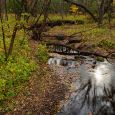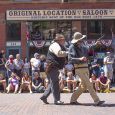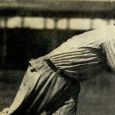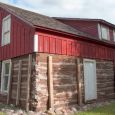The Gift of South Dakota
Subscriptions to South Dakota Magazine make great gifts!
Subscribe today — 1 year (6 issues) is just $29!
West Friends
 |
| Black Hills lawman Seth Bullock led the efforts to build Friendship Tower, a memorial to his friend Theodore Roosevelt near Deadwood. Photo by John Mitchell |
The Mount Roosevelt Friendship Tower Trail, says Black Hills National Forest North Zone Archaeologist Michael Engelhart, can be thought of as an easy “tiptoe into the woods.” For children, or adults unaccustomed to long Black Hills hikes, the trail is a mile-high, 0.6-mile loop that’s moderately rugged and gains altitude as it passes through pines and aspens. It offers vistas of the northern Black Hills and adjacent plains.
The site is also a step into local and national history, a perfect tribute to President Theodore Roosevelt, who knew these hills and plains well, and labored hard to preserve all western lands.
The trail leads to a 35-foot-tall rough-hewn stone tower, a structure that some observers liken to an artifact straight from medieval Europe, or a gigantic chess piece. In fact, the tower was the nation’s first memorial to Roosevelt, erected in a flurry just months after the 26th president died in 1919.
Pushing aggressively for the memorial, as soon as he learned of Roosevelt’s death that January, was Seth Bullock — former Deadwood sheriff, marshal, Rough Rider, U.S. Forest Reserve superintendent, and posthumously the inspiration for a character in HBO’s Deadwood TV series. Photos taken at the tower’s July 4, 1919, dedication reveal Bullock looking unusually weary and drawn. Working with the Society of Black Hills Pioneers, Bullock had obtained land on Sheep Mountain 3 miles northwest of Deadwood, renamed it Mount Roosevelt, led the memorial tower’s construction, and organized a high-powered dedication program — all while battling intestinal cancer. Bullock died on September 23, 12 weeks after the dedication. He was 70.
Yes, the tower officially memorialized the president. But it also stood in testament to two remarkable friends — Roosevelt and Bullock — and people alternately called it the “Friendship Tower.” The stone structure has endured for more than a century, though in that time the elements took their toll. But a recent restoration and rededication project led by the U.S. Forest Service has encouraged hikers to traverse the trail and once again visit the magnificent monument that forever links two of the West’s most intelligent and hard-nosed characters.
 |
| Bullock and Roosevelt met while the future president was ranching in northern Dakota Territory. They remained friends the rest of their lives. |
Bullock was born in Canada in 1849, moved to Michigan with his family, and hoped to serve in the Union Army during the Civil War, but it ended before he was old enough to enlist. At age 20 he embarked on a different kind of adventure to Montana Territory’s gold fields.
His biographer, David Wolff of Spearfish, writes that despite Bullock’s thirst for rugged outdoor adventure, he had taken school seriously and grown up to speak softly and properly like an educated gentleman. Wolff added that Bullock was strong-willed, “with firm opinions to match. He befriended people he saw as equals and ignored those he looked down upon.”
Except when people he looked down upon were outlaws that he arrested as a Montana and Dakota lawman. He believed they impeded vital progress in the West. After nearly a decade in Montana, Bullock rode into Deadwood, part of the great Black Hills gold rush that boomed in 1876 (ironically, the courts would eventually determine the gold rush itself was outlawry, because the Black Hills were reserved for the Lakota people in 1876). For a few months he served as Deadwood sheriff.
Among the people that Bullock ranked as his equal was Roosevelt, nine years younger than himself and a New Yorker. After Roosevelt’s first wife Alice died, the future president sought solace in Dakota Territory. In the process, he became a cattleman and jumped into civic affairs as fledgling units of government took form. An enduring legend claims that Bullock and Roosevelt first encountered one another as each was pursuing the same horse thief. Wolff, however, believes the pair met along the Belle Fourche River in 1892, and that when Roosevelt announced he was currently serving as a federal civil service commissioner, Bullock was impressed. While that story isn’t as colorful as the one involving a horse thief, it points to the men’s mutual belief in government and civil authority as means for moving the West forward.
Beyond that, what cemented the Bullock-Roosevelt friendship? According to Roosevelt, Bullock was a man who could always get him to laugh, and that counted for a lot in a life touched by personal sorrows and the immense pressures of the presidency. A story Roosevelt loved was the time the two men were in London, and Bullock approached a stuffy-looking Englishman and asked him the name of a nearby “creek” — knowing full well it was the River Thames.
The men were in London because Roosevelt wanted, “Britishers to see my typical ideal American.” That, to Roosevelt’s thinking, had to be a westerner. After he remarried and had sons, who grew up in New York and Washington, D.C., Roosevelt sent the boys on South Dakota vacations so that under Bullock’s tutelage they would become westerners, not greenhorns.
 |
| Seth Bullock is pictured at the While House with President Roosevelt during a reunion of Roosevelt's Rough Riders. |
In Bullock and Roosevelt’s minds, the toughest westerners were working cowboys. The men successfully advanced an idea to send mounted cowboys — Rough Riders — into combat during the Spanish-American War. These cowboys mostly hailed from the Dakotas and neighboring states. Although he was 50, Bullock jumped into the Rough Rider adventure, and volunteered to do so again at age 70 during World War I.
As had been the case in the Civil War, however, Bullock missed seeing combat in the Spanish-American War. But Roosevelt did, making his famous charge up San Juan Hill in Cuba that became a key to launching his national political career. He was elected vice president in 1900 and assumed the presidency following President William McKinley’s assassination in September 1901. Just nine years had passed since Roosevelt, on horseback along the Belle Fourche River, had introduced himself as a federal civil service commissioner.
Much later, in 1927, President Calvin Coolidge would bring the federal government’s executive branch to South Dakota for three months when he established his “summer White House” in the Black Hills. Yet no American president understood the state more intimately than Theodore Roosevelt. To use modern terminology, Roosevelt was “hands-on” in executing policy in South Dakota, including reclamation that would create Belle Fourche Reservoir and his 1902 order for stock growers to remove unauthorized cattle grazing on the Rosebud and Pine Ridge Indian reservations. The resulting 1902 Roundup is legendary today, but at the time was seen chiefly as reflecting the president’s concern about reservation lands that were being damaged by overgrazing.
Likewise, Roosevelt worried about limited timber and water resources in the Black Hills. So did Bullock, who noted that all local industries were dependent on those resources and that their loss could turn the Black Hills into “a desert.”
This concern prompted Roosevelt, as vice president, to convince McKinley that the president should appoint Bullock supervisor of the Black Hills Forest Reserve — today the Black Hills National Forest. This Reserve, established in 1897, had already made history as the site of the nation’s first federal timber sale — about 30 miles south of what would become Mount Roosevelt. This regulated sale of timber to loggers was a big step as national forests everywhere embraced a multiple-use philosophy, with private industry playing a role in forest management.
Still, there were plenty of Black Hills people appalled by the thought of the federal government asserting itself into a forest they considered their own. Roosevelt sensed correctly that South Dakotans would accept Bullock as the face of the Forest Reserve over an outside bureaucrat. Roosevelt settled into the White House confident he had the right man — based in Deadwood — to fight fires, chase timber and game poachers out of the forest, handle timber sales, and encourage replanting efforts that would rejuvenate overcut forests (it was later determined that the Black Hills usually regenerate pine growth naturally).
 |
| Gen. Leonard Wood and Seth Bullock posed in the foreground of a photo during the dedication of the Friendship Tower. Around 1,000 people attended the ceremony. |
In 1906 the president named Bullock, who had secured a firm place in history as a pioneer forest manager, to the South Dakota U.S. marshal position. Bullock set up his office in Deadwood; the westerner had no intention of living in Sioux Falls, the established base of operations for marshals.
Roosevelt chose not to seek re-election in 1908 and regretted it immediately. When he attempted to regain the White House in 1912, Bullock — still South Dakota’s marshal — campaigned for him. But Roosevelt’s comeback resulted in little except a badly-fractured Republican Party and a bullet left lodged in the ex-president’s chest after a campaign trail assassination attempt. Later, Roosevelt’s rigorous exploration trek to South America left him ill and injured, further compromising his overall health. Bullock contracted his cancer at about the same time.
But World War I proved to be the saddest struggle for the friends. President Woodrow Wilson nixed their hopes to reorganize the Rough Riders for combat in Europe. In July 1918, Roosevelt’s son Quentin died in an aerial battle over France. Six months later, Roosevelt himself passed away in his sleep at age 60.
The Society of Black Hills Pioneers and Deadwood civic leaders liked Bullock’s idea of honoring Roosevelt permanently in the Black Hills, but believed the memorial should stand in Deadwood, not miles out of town up a very steep grade. A revised plan could allow visitors to step off the train in Deadwood and walk to the site. Bullock dug in his heels and successfully made the case that Roosevelt’s chief legacy in the West was preservation and protection of lands. Bullock wanted visitors to experience those lands, to climb a winding metal staircase in the tower and survey them as far as their eyes could see.
A thousand people made their way to the tower’s dedication on Independence Day. The program Bullock arranged was, appropriate to the man being honored, awash in Republican politics. Gov. Peter Norbeck, whose natural preservation philosophy mirrored Roosevelt’s, spoke. So did Gen. Leonard Wood, Roosevelt’s Army commander during his San Juan Hill charge 21 years earlier. Wood was preparing to run for president himself, on a platform Roosevelt would have approved. Wood, in fact, came close to winning the Republican nomination in 1920.
In the 1920s and ’30s, automobile tourism surpassed vacation travel by rail into the Black Hills. Deadwood’s municipally owned Pine Crest Tourist Park catered to those new-era tourists and sat within hiking distance of the tower. For locals, the spot was a popular picnic venue when a road took their cars right up to the structure. The great Deadwood forest fire of 1959 nearly wiped out the town; flames came within a half-mile of the tower. In years following the fire, school groups, Boy Scouts and Girl Scouts, and others made trips to the tower to gaze across charred hillsides and absorb the destructive fury of wildfire. Some youth on these field trips grew up believing Mount Roosevelt had always been Forest Service land and the tower a fire lookout.
In fact, the Society of Black Hills Pioneers transferred the site to the Forest Service in 1966. By that time, it seemed every Black Hills teenager had access to a car, and some of them discovered Mount Roosevelt to be a dark, secluded destination for underage beer parties. Some mornings broken bottles littered the tower’s base. The Forest Service closed the road leading to the tower, and for safety removed stone steps that took people into the tower. The interior metal stairway was also blocked.
 |
| When visitors reached the top of Friendship Tower, Bullock wanted them to enjoy a sweeping view of the Black Hills that he and Roosevelt both loved. Photo by John Mitchell |
More damaging than glass was water — season after season of rain and snowmelt that slowly broke down mortar between the tower’s stones. Brett Ewald, Forest Service archaeological technician, says the situation never reached the level of “benign neglect,” where a site begins a slide into complete deterioration. “But,” he says, “the Forest Service did come to a point where it had to reassess how it managed the tower.”
A condition survey in 2001 was the start of a sequence that saw the tower added to the National Register of Historic Places in 2005, and then survey recommendations were gradually fulfilled, including stabilizing the base, replacing the exterior stone steps and unblocking the metal interior ones, and working up new visitor interpretation. The loop trail from the parking lot was fully developed, and a metal cupola added to the tower’s top to improve drainage.
The site was rededicated exactly 100 years after Bullock’s original dedication. Some local people who attended admitted it was their first visit, while others declared decades-long affection for Mount Roosevelt.
It’s fair to say that the memorial has never won the national attention that Bullock hoped, but another Black Hills monument certainly has. If Bullock had lived another 20 years, he surely would have attended the 1939 dedication of his friend’s likeness on Mount Rushmore. Had someone asked if Roosevelt really merited inclusion with Washington, Jefferson and Lincoln, there’s little doubt that Bullock would have defended his old friend, whose granite gaze now falls forever over the rugged land that they both so loved.
Editor’s Note: This story is revised from the May/June 2020 issue of South Dakota Magazine. To order a copy or to subscribe, call (800) 456-5117.










Comments